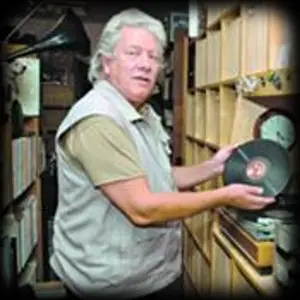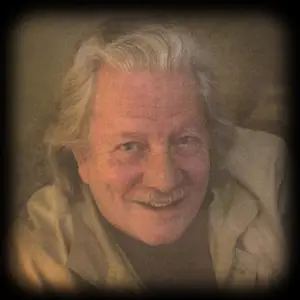BRUCE BASTIN
 In 1958, Muddy Waters played a gig at St. Pancras Town Hall in London as guest of Chris Barber, the bandleader whose love of the Blues was to spark the British Blues Boom in the following decade. In the audience that night was a teenaged Bruce Bastin, the future musicologist, writer and label owner whose seminal book, ‘Red River Blues’ gave us the term ‘Piedmont Blues‘ for the light, fingerpicking style of guitarists from the Eastern Seaboard. Bruce describes that London concert as “a life-changing event” that inspired his later career in music.
In 1958, Muddy Waters played a gig at St. Pancras Town Hall in London as guest of Chris Barber, the bandleader whose love of the Blues was to spark the British Blues Boom in the following decade. In the audience that night was a teenaged Bruce Bastin, the future musicologist, writer and label owner whose seminal book, ‘Red River Blues’ gave us the term ‘Piedmont Blues‘ for the light, fingerpicking style of guitarists from the Eastern Seaboard. Bruce describes that London concert as “a life-changing event” that inspired his later career in music.
Wilton James Bruce Bastin was born in Chelmsford, Essex two weeks after the start of WWII, and as a ‘war baby’ he moved around a good deal before attending Purley Grammar School in Surrey. While Bruce was studying at London University in the late 50s, his room-mate played him Walter ‘Buddy Boy’ Hawkins’ song ‘Jailhouse Fire’ on a 10” record, and his passion for the Blues was confirmed soon afterwards at that concert with Muddy. After working a few years as a Geography teacher, Bruce visited The States in 1964, touring the South and the West-coast in an ambulance converted into an RV. The trip lasted for two whole years, and while spending some time in Houston, Bruce discovered a garage-full of old Blues records on Westheimer Street. He bought stacks of them and shipped them to Britain to form the foundations of an extensive collection of music.
 Back in Britain, Bruce returned to teaching, using the summer recesses to revisit America. He explored Louisiana in 1968, when he worked on a cajun radio station, and went on a ‘scouting trip’ on the Eastern Seaboard with his long-time friend and collaborator Pete Lowry the following year, which yielded another “room-full” of 78s in a small-town record store in Georgia, many of which he exported. Bruce had begun to write about his experiences for Blues Unlimited magazine, and with editor Simon Napier he set up Flyright Records. They began by re-issuing the work of little-known Blues players and, under the Interstate Records umbrella, expanded into the Heritage, Krazy Kat and Magpie labels which issued all kinds of interesting and unusual records from Cuba and Latin-America, Tango music from Argentina and African music from the West and South, including tracks dating back to the 20s. They also went on to record many American Blues stars when they passed through Europe.
Back in Britain, Bruce returned to teaching, using the summer recesses to revisit America. He explored Louisiana in 1968, when he worked on a cajun radio station, and went on a ‘scouting trip’ on the Eastern Seaboard with his long-time friend and collaborator Pete Lowry the following year, which yielded another “room-full” of 78s in a small-town record store in Georgia, many of which he exported. Bruce had begun to write about his experiences for Blues Unlimited magazine, and with editor Simon Napier he set up Flyright Records. They began by re-issuing the work of little-known Blues players and, under the Interstate Records umbrella, expanded into the Heritage, Krazy Kat and Magpie labels which issued all kinds of interesting and unusual records from Cuba and Latin-America, Tango music from Argentina and African music from the West and South, including tracks dating back to the 20s. They also went on to record many American Blues stars when they passed through Europe.
In 1970, Bruce returned for another mission to the East-coast, and back in England his travel notes were rapidly re-written into his first book, ‘Cryin’ for the Carolines’. This fuelled his interest into the context of the music he loved, so he enrolled for a Masters Degree in Folklore and History at the University of North Carolina in Chapel Hill, under the renowned Professor Dan Patterson. While studying there, Bruce helped to organise a Blues Festival in 1973 with Peg-Leg Sam, Tarheel Slim, Woody Trice and JB Hutto, and worked with Tom Davenport on his film ‘The Last Medicine Show’. During the 70s and 80s Bruce recorded many artists for his Interstate labels, both in America and in Europe, contributed to several Blues magazines, wrote countless sleeve notes and continued to collect music from all over the world.
Bruce published his definitive story of Piedmont Blues in 1986, which looked at the social and economic context of the music, as well as drawing attention to some of its less well-known exponents. In ‘Red River Blues’, Bruce (ever the Geography teacher!) coined the description ‘Piedmont Blues’ for the music of the Eastern Coastal Plain, but he modestly allows that the term may have emerged during discussions with Pete Lowry while on their extensive journeyings. In 1990, along with contributor Kip Lornell, Bruce published a biography of New York music mogul Joe Davis entitled ‘Never Sell a Copyright’, later re-issued as ‘Melody Man’. Still running the Interstate labels and still an active collector of all kinds of music, Bruce donated a 10,000 record selection of his accumulated treasures to The Uni. Of Cal. Santa Barbara in 2008. They are catalogued and archived so that the music Bruce loves will be kept available for future generations.
